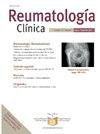系统性红斑狼疮患者甲襞毛细血管镜改变:与疾病活动性和抗尿苷-核糖核蛋白抗体相关
IF 1.2
Q4 RHEUMATOLOGY
引用次数: 0
摘要
系统性红斑狼疮(SLE)是一种自身免疫性疾病,可引起多种血管并发症,包括内皮细胞损伤。甲襞毛细血管镜检查是评估甲襞毛细血管形态最有效的无创成像技术,约半数SLE患者存在非特异性甲襞毛细血管镜检查异常。抗尿苷-核糖核蛋白抗体存在于系统性红斑狼疮患者中,伴有雷诺现象、肺动脉高压、食管运动障碍、肌病,无严重肾脏受累。目的探讨SLE患者甲襞毛细血管镜下不同形态的变化及其与SLE疾病活动性及抗u1 - rnp抗体的相关性。患者和方法一项病例对照研究包括86例SLE患者,使用SLEDAI-2K评估疾病活动性。所有患者均行甲襞毛细血管镜检查。所有患者均检测抗尿苷-核糖核蛋白抗体。结果抗尿苷-核糖核蛋白抗体与微出血呈显著负相关,抗dsdna抗体阳性与微出血呈显著直接相关。此外,巨毛细血管、静脉丛可见性与较高的ESR和CRP之间存在显著的直接相关性。雷诺现象与SLEDAI-2K、关节肿胀、关节压痛、抗dsdna显著相关。多元线性回归分析显示,微出血和巨毛细血管是红斑狼疮疾病活动性的最显著预测因子。结论我们的研究结果强调了系统性红斑狼疮微血管异常的患病率,包括扭曲、交叉、伸长、微出血和巨毛细血管,强调了NFC在评估微循环和疾病活动性方面的重要性。此外,它增加了越来越多的证据来支持毛细血管异常的预后价值,特别是微出血和巨毛细血管,作为系统性红斑狼疮患者疾病活动的预测因子。甲襞毛细血管镜检查可以评估狼疮活动和潜在的预测严重并发症的风险。本文章由计算机程序翻译,如有差异,请以英文原文为准。
Nailfold capillaroscopy changes in systemic lupus erythematosus patients: Correlation with disease activity and anti-uridin1-ribonucleoprotein antibodies
Introduction
Systemic lupus erythematosus (SLE) is an autoimmune disease that causes multiple vascular complications, including endothelial cell damage. Nailfold capillaroscopy is the most effective non-invasive imaging technique for assessing the morphology of nailfold capillaries, and approximately half of the SLE patients have non-specific nailfold capillaroscopy abnormalities. Anti-uridin1-ribonucleoprotein antibodies are present in systemic lupus erythematosus patients with Raynaud's phenomenon, pulmonary artery hypertension, esophageal dysmotility, myopathy, and no severe renal involvement.
Aim
To detect different patterns of nailfold capillaroscopic changes in SLE patients, their correlation with SLE disease activity, and anti-U1-RNP antibodies.
Patients and methods
A case–control study included eighty-six SLE patients, and disease activity was assessed using the SLEDAI-2K. All patients had a nailfold capillaroscopic examination. Anti-uridin1-ribonucleoprotein antibodies were measured in all patients.
Results
Anti-uridin1-ribonucleoprotein antibodies had a significant inverse correlation with microhemorrhages and a significant direct relationship between anti-dsDNA antibody positivity and the presence of microhemorrhage. Additionally, a significant direct correlation was found between giant capillaries, venous plexus visibility, and higher ESR and CRP. Raynaud's phenomenon was significantly correlated with SLEDAI-2K, swollen joints, tender joints, and anti-dsDNA. Multiple linear regression analysis revealed that microhemorrhages and giant capillaries were the most significant predictors of lupus disease activity.
Conclusion
Our findings highlight the prevalence of microvascular abnormalities in systemic lupus erythematosus, including tortuosity, crossing, elongation, microhemorrhages, and giant capillaries, emphasizing the importance of NFC in assessing microcirculation and disease activity. Also, it adds to the growing body of evidence supporting the prognostic value of capillary abnormalities, particularly microhemorrhages and giant capillaries, as predictors of disease activity in systemic lupus erythematosus patients. Nailfold capillaroscopic examination can assess lupus activity and potentially predict the risk of serious complications.
求助全文
通过发布文献求助,成功后即可免费获取论文全文。
去求助
来源期刊

Reumatologia Clinica
RHEUMATOLOGY-
CiteScore
2.40
自引率
6.70%
发文量
105
审稿时长
54 days
期刊介绍:
Una gran revista para cubrir eficazmente las necesidades de conocimientos en una patología de etiología, expresividad clínica y tratamiento tan amplios. Además es La Publicación Oficial de la Sociedad Española de Reumatología y del Colegio Mexicano de Reumatología y está incluida en los más prestigiosos índices de referencia en medicina.
 求助内容:
求助内容: 应助结果提醒方式:
应助结果提醒方式:


